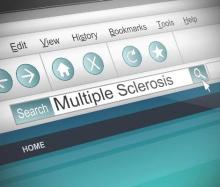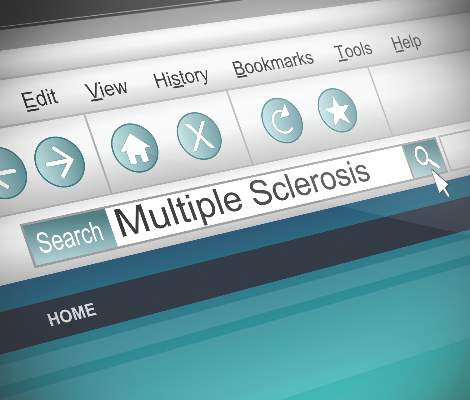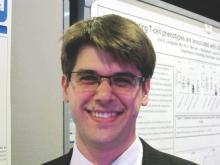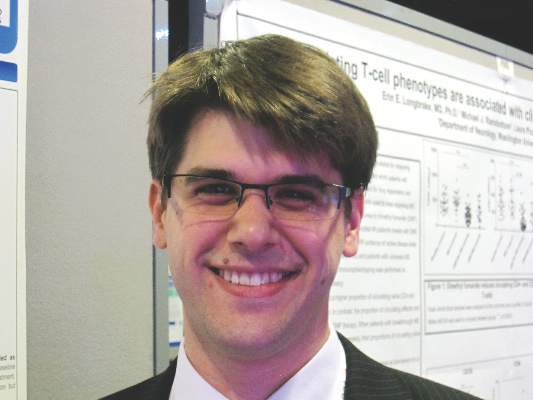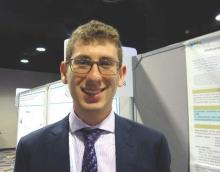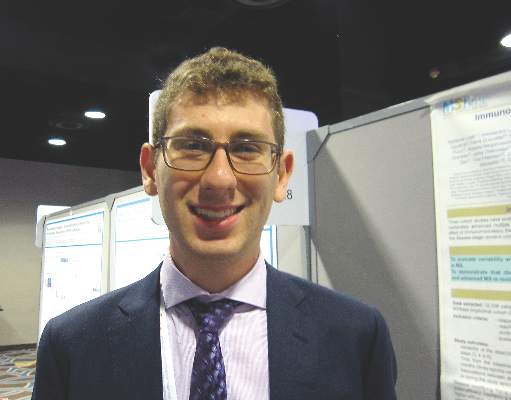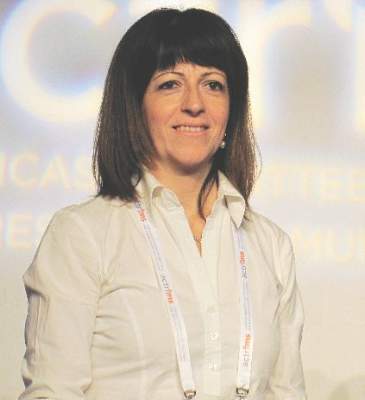User login
Multiple Sclerosis Hub
Fingolimod improved gait impairment in small study
NEW ORLEANS – Treatment with fingolimod improved gait impairment in treatment-naive multiple sclerosis (MS) patients and those on a previous first-line therapy in a small, single-center study.
“Fingolimod [Gilenya] is the first disease-modifying treatment shown to improve gait impairment in MS,” commented Dr. Soledad Pérez-Sánchez of Virgen Macarena University Hospital, Seville, Spain, who presented the study as a poster at the meeting held by the Americas Committee for Treatment and Research in Multiple Sclerosis.
The investigators also found that patients who were unsuccessfully treated with natalizumab (Tysabri) prior to fingolimod did not improve their gait during the course of the 6-month study. Natalizumab is a second-line drug in Spain, and fingolimod is a second-line therapy there as well, except in cases of aggressive onset of disease, according to the investigators.
Of 36 patients in the study, 24 were treatment-naïve/first-line patients (17 females and 7 males; mean age, 38.25 years), with the remaining 12 (9 females, 3 males; mean age, 44.25 years) having been treated with natalizumab. The mean duration of MS was 11.2 years in the naïve/first-line group and 17.9 years in patients on natalizumab prior to fingolimod. The mean Extended Disability Status Scale score in the two groups was similar at 3.79 and 3.38, respectively.
The investigators measured gait profile changes during fingolimod treatment with the Gaitrite Electronic System, which comprises an electronic pathway equipped with sensors designed to measure the timing and position of walking. The measurement parameters included velocity, ambulation time, and functional ambulation profile (FAP), the time to move unassisted through five common environmental terrains.
All patients completed the walking test prior to treatment and 3 months after treatment. At 6 months, 20 naïve/first-line patients and 11 patients previously on natalizumab completed the test. For each group of patients, the results prior to treatment and 3 months after were statistically similar. But significant differences were evident for naïve/first-line patients between the 3- and 6-month measures of velocity (89.10±31.03 to 100.70±23.75 cm/s; P = .01) and FAP (82.81±16.93 to 91.95±9.02 seconds; P = .01). These measurements trended toward significance when the values prior to treatment and 6 months after treatment were compared (P = .096, .077, and .065, in the same respective order).
Patients who had been treated with natalizumab did not display appreciable changes in velocity, ambulation time, and FAP.
“Our study shows that fingolimod improves gait impairment in naïve patients and those switched from first-line therapy. Our data are consistent with other clinical measures published so far which have pointed to better outcomes with fingolimod in naïve/first-line patients than in natalizumab-switched patients,” Dr. Pérez-Sánchez and her colleagues said.
The single-center study design and small number of patients limit any conclusions on the use of fingolimod as a gait-improving therapy in MS until further studies are completed, according to the researchers.
Funding was provided by Novartis. Dr. Pérez-Sánchez had no disclosures.
NEW ORLEANS – Treatment with fingolimod improved gait impairment in treatment-naive multiple sclerosis (MS) patients and those on a previous first-line therapy in a small, single-center study.
“Fingolimod [Gilenya] is the first disease-modifying treatment shown to improve gait impairment in MS,” commented Dr. Soledad Pérez-Sánchez of Virgen Macarena University Hospital, Seville, Spain, who presented the study as a poster at the meeting held by the Americas Committee for Treatment and Research in Multiple Sclerosis.
The investigators also found that patients who were unsuccessfully treated with natalizumab (Tysabri) prior to fingolimod did not improve their gait during the course of the 6-month study. Natalizumab is a second-line drug in Spain, and fingolimod is a second-line therapy there as well, except in cases of aggressive onset of disease, according to the investigators.
Of 36 patients in the study, 24 were treatment-naïve/first-line patients (17 females and 7 males; mean age, 38.25 years), with the remaining 12 (9 females, 3 males; mean age, 44.25 years) having been treated with natalizumab. The mean duration of MS was 11.2 years in the naïve/first-line group and 17.9 years in patients on natalizumab prior to fingolimod. The mean Extended Disability Status Scale score in the two groups was similar at 3.79 and 3.38, respectively.
The investigators measured gait profile changes during fingolimod treatment with the Gaitrite Electronic System, which comprises an electronic pathway equipped with sensors designed to measure the timing and position of walking. The measurement parameters included velocity, ambulation time, and functional ambulation profile (FAP), the time to move unassisted through five common environmental terrains.
All patients completed the walking test prior to treatment and 3 months after treatment. At 6 months, 20 naïve/first-line patients and 11 patients previously on natalizumab completed the test. For each group of patients, the results prior to treatment and 3 months after were statistically similar. But significant differences were evident for naïve/first-line patients between the 3- and 6-month measures of velocity (89.10±31.03 to 100.70±23.75 cm/s; P = .01) and FAP (82.81±16.93 to 91.95±9.02 seconds; P = .01). These measurements trended toward significance when the values prior to treatment and 6 months after treatment were compared (P = .096, .077, and .065, in the same respective order).
Patients who had been treated with natalizumab did not display appreciable changes in velocity, ambulation time, and FAP.
“Our study shows that fingolimod improves gait impairment in naïve patients and those switched from first-line therapy. Our data are consistent with other clinical measures published so far which have pointed to better outcomes with fingolimod in naïve/first-line patients than in natalizumab-switched patients,” Dr. Pérez-Sánchez and her colleagues said.
The single-center study design and small number of patients limit any conclusions on the use of fingolimod as a gait-improving therapy in MS until further studies are completed, according to the researchers.
Funding was provided by Novartis. Dr. Pérez-Sánchez had no disclosures.
NEW ORLEANS – Treatment with fingolimod improved gait impairment in treatment-naive multiple sclerosis (MS) patients and those on a previous first-line therapy in a small, single-center study.
“Fingolimod [Gilenya] is the first disease-modifying treatment shown to improve gait impairment in MS,” commented Dr. Soledad Pérez-Sánchez of Virgen Macarena University Hospital, Seville, Spain, who presented the study as a poster at the meeting held by the Americas Committee for Treatment and Research in Multiple Sclerosis.
The investigators also found that patients who were unsuccessfully treated with natalizumab (Tysabri) prior to fingolimod did not improve their gait during the course of the 6-month study. Natalizumab is a second-line drug in Spain, and fingolimod is a second-line therapy there as well, except in cases of aggressive onset of disease, according to the investigators.
Of 36 patients in the study, 24 were treatment-naïve/first-line patients (17 females and 7 males; mean age, 38.25 years), with the remaining 12 (9 females, 3 males; mean age, 44.25 years) having been treated with natalizumab. The mean duration of MS was 11.2 years in the naïve/first-line group and 17.9 years in patients on natalizumab prior to fingolimod. The mean Extended Disability Status Scale score in the two groups was similar at 3.79 and 3.38, respectively.
The investigators measured gait profile changes during fingolimod treatment with the Gaitrite Electronic System, which comprises an electronic pathway equipped with sensors designed to measure the timing and position of walking. The measurement parameters included velocity, ambulation time, and functional ambulation profile (FAP), the time to move unassisted through five common environmental terrains.
All patients completed the walking test prior to treatment and 3 months after treatment. At 6 months, 20 naïve/first-line patients and 11 patients previously on natalizumab completed the test. For each group of patients, the results prior to treatment and 3 months after were statistically similar. But significant differences were evident for naïve/first-line patients between the 3- and 6-month measures of velocity (89.10±31.03 to 100.70±23.75 cm/s; P = .01) and FAP (82.81±16.93 to 91.95±9.02 seconds; P = .01). These measurements trended toward significance when the values prior to treatment and 6 months after treatment were compared (P = .096, .077, and .065, in the same respective order).
Patients who had been treated with natalizumab did not display appreciable changes in velocity, ambulation time, and FAP.
“Our study shows that fingolimod improves gait impairment in naïve patients and those switched from first-line therapy. Our data are consistent with other clinical measures published so far which have pointed to better outcomes with fingolimod in naïve/first-line patients than in natalizumab-switched patients,” Dr. Pérez-Sánchez and her colleagues said.
The single-center study design and small number of patients limit any conclusions on the use of fingolimod as a gait-improving therapy in MS until further studies are completed, according to the researchers.
Funding was provided by Novartis. Dr. Pérez-Sánchez had no disclosures.
AT ACTRIMS FORUM 2016
Key clinical point: Fingolimod shows signs that it may improve gait in MS patients who are naive to treatment or have only received first-line therapy.
Major finding: Significant differences were evident for naïve/first-line patients between the 3- and 6-month measures of velocity (89.10±31.03 to 100.70±23.75 cm/s; P = .01) and functional ambulation profile (82.81±16.93 to 91.95±9.02 seconds; P = .01).
Data source: Single-center study of 36 patients.
Disclosures: Funding was provided by Novartis. Dr. Pérez-Sánchez had no disclosures.
VIDEO: Novel tools measure disease progression in MS
NEW ORLEANS – The visual system is relevant and accessible for the study of multiple sclerosis and can aid in the measurement of neuronal and axonal injury.
Capturing primary neuronal loss in the afferent visual pathway was among the topics addressed during a session focused on novel methods for measuring disease progression in MS at a meeting held by the Americas Committee for Treatment and Research in Multiple Sclerosis.
In this video interview at the meeting, session chair Dr. Fiona Costello of the University of Calgary, Alta., discussed the presentation on the visual pathway, as well as presentations on the use of microRNA biomarkers and the use of MRI as an outcome measure in progressive MS.
“The gestalt is that the field is moving in a new direction; the field is looking for not only a better understanding of what causes disability in MS, but also more reliable, objective, accessible means of capturing the same thing that is relevant and meaningful to patients and their caretakers,” she said.
The video associated with this article is no longer available on this site. Please view all of our videos on the MDedge YouTube channel
NEW ORLEANS – The visual system is relevant and accessible for the study of multiple sclerosis and can aid in the measurement of neuronal and axonal injury.
Capturing primary neuronal loss in the afferent visual pathway was among the topics addressed during a session focused on novel methods for measuring disease progression in MS at a meeting held by the Americas Committee for Treatment and Research in Multiple Sclerosis.
In this video interview at the meeting, session chair Dr. Fiona Costello of the University of Calgary, Alta., discussed the presentation on the visual pathway, as well as presentations on the use of microRNA biomarkers and the use of MRI as an outcome measure in progressive MS.
“The gestalt is that the field is moving in a new direction; the field is looking for not only a better understanding of what causes disability in MS, but also more reliable, objective, accessible means of capturing the same thing that is relevant and meaningful to patients and their caretakers,” she said.
The video associated with this article is no longer available on this site. Please view all of our videos on the MDedge YouTube channel
NEW ORLEANS – The visual system is relevant and accessible for the study of multiple sclerosis and can aid in the measurement of neuronal and axonal injury.
Capturing primary neuronal loss in the afferent visual pathway was among the topics addressed during a session focused on novel methods for measuring disease progression in MS at a meeting held by the Americas Committee for Treatment and Research in Multiple Sclerosis.
In this video interview at the meeting, session chair Dr. Fiona Costello of the University of Calgary, Alta., discussed the presentation on the visual pathway, as well as presentations on the use of microRNA biomarkers and the use of MRI as an outcome measure in progressive MS.
“The gestalt is that the field is moving in a new direction; the field is looking for not only a better understanding of what causes disability in MS, but also more reliable, objective, accessible means of capturing the same thing that is relevant and meaningful to patients and their caretakers,” she said.
The video associated with this article is no longer available on this site. Please view all of our videos on the MDedge YouTube channel
AT ACTRIMS FORUM 2016
Positive headway reported for progressive multiple sclerosis
NEW ORLEANS – On top of the first success with an investigational pharmaceutical agent for primary progressive multiple sclerosis reported last year, the otherwise negative results from recent clinical trials in progressive disease are at least informing the field of which direction to take in future research, Dr. Fred D. Lublin said at a meeting held by the Americas Committee for Treatment and Research in Multiple Sclerosis.
“The breaking news is that we are making headway. Two years ago we didn’t have a clue. Now we have clues,” said Dr. Lublin, professor of neurology and director of the Corinne Goldsmith Dickinson Center for Multiple Sclerosis at Mount Sinai Medical Center, New York.
In the ORATORIO trial, the selective B-cell–targeting monoclonal antibody ocrelizumab (600 mg intravenous infused every 6 months as two 300-mg infusions given 2 weeks apart) was compared with placebo in 732 people with primary progressive MS (PPMS) in a 120-week blinded treatment continued for at least 120 weeks. After 24 weeks of treatment, ocrelizumab lessened the risk of progression in clinical disability by 25%, compared with placebo. Over the 2-year blinded treatment, the volume of hyperintense T2 lesions was reduced by 3.4% in the treatment arm, compared with a 7% increase in the placebo arm. Rate of whole brain volume loss was also reduced. A subgroup analysis presented at the ACTRIMS Forum revealed the influence of gadolinium-enhanced lesions on treatment efficacy.
“ORATORIO has opened the door to the problem of solving progressive MS”, said Dr. Lublin. Yet, considerable challenges remain. This was true even in the ORATORIO trial, where the treatment success was tempered by a 2.3% rate of malignancies in patients receiving ocrelizumab, which was more than double the 0.8% rate in the placebo arm.
Impact of trial design
The ORATORIO trial also highlighted another conundrum of trials to date, namely patient selection. The trial was designed to include young people with brain inflammation, a population that can respond well to treatment. But, in real life, patients with progressive MS can be older without signs of inflammation. For them, and for patients with a longer history of progressive MS, treatment might be less effective.
Other aspects of trial design that can bear on the outcome include the target (inflammation or degeneration), who to target, how to measure treatment outcome, and whether the endpoint is a confirmed decline that persists for a defined time or the more rigorous sustained decline, in which the decline is maintained for the course of the study. The disease phenotypes can also be important in trial design when it comes to screening patients. For example, one recognized MS phenotype is an active form that features clinical relapses and/or gadolinium-enhancing lesions on MRI, but which does not progress. Inclusion of this phenotype in a study can dilute the power of the study to detect a treatment effect if the progressive disease is in a nonprogressive phase during the study period.
Subgroup analysis of a trial with a failed primary outcome may reveal some patients who respond better to treatment, as in the OLYMPUS randomized, placebo-controlled trial. While the difference to confirmed disease progression in PPMS between rituximab and placebo was not significant overall, disease progression was significantly delayed in older patients.
Informative negative trials
With a solid trial design, a failed outcome can be informative, as it is likely because of a biological reason rather than a faulty trial design. The randomized, double-blind, phase III INFORMS trial of fingolimod versus placebo in PPMS is an example. While the primary and secondary outcomes involving delay to 3-month confirmed disease progression were not met, fingolimod treatment was associated with significantly fewer T2 and gadolinium-enhanced T1 lesions. Scrutiny of the study results could inform future trials.
A second example is the ASCEND trial of natalizumab in patients with secondary progressive MS. The trial’s failure likely reflected the very rigorous primary endpoint of a delay of confirmed disease progression at 3 months that was sustained up to 6 months or longer.
The MS-SPI randomized, multicenter, double-blind, placebo-controlled study that evaluated oral biotin in patients with PPMS or secondary progressive MS was especially noteworthy for its primary endpoint of improvement in disease at 1 year. The endpoint was met by 13% of those in the treatment arm versus 0% in the placebo arm (P = .0051).
“I wish I had more breaking news to report. But we are making progress with progressive disease. We learn from each study, and we are developing a clearer understanding of how to more effectively approach progression,” Dr. Lublin said.
Dr. Lublin reported receiving research support and/or serving as a consultant for many companies marketing MS drugs, including Biogen, Genentech, and Novartis.
NEW ORLEANS – On top of the first success with an investigational pharmaceutical agent for primary progressive multiple sclerosis reported last year, the otherwise negative results from recent clinical trials in progressive disease are at least informing the field of which direction to take in future research, Dr. Fred D. Lublin said at a meeting held by the Americas Committee for Treatment and Research in Multiple Sclerosis.
“The breaking news is that we are making headway. Two years ago we didn’t have a clue. Now we have clues,” said Dr. Lublin, professor of neurology and director of the Corinne Goldsmith Dickinson Center for Multiple Sclerosis at Mount Sinai Medical Center, New York.
In the ORATORIO trial, the selective B-cell–targeting monoclonal antibody ocrelizumab (600 mg intravenous infused every 6 months as two 300-mg infusions given 2 weeks apart) was compared with placebo in 732 people with primary progressive MS (PPMS) in a 120-week blinded treatment continued for at least 120 weeks. After 24 weeks of treatment, ocrelizumab lessened the risk of progression in clinical disability by 25%, compared with placebo. Over the 2-year blinded treatment, the volume of hyperintense T2 lesions was reduced by 3.4% in the treatment arm, compared with a 7% increase in the placebo arm. Rate of whole brain volume loss was also reduced. A subgroup analysis presented at the ACTRIMS Forum revealed the influence of gadolinium-enhanced lesions on treatment efficacy.
“ORATORIO has opened the door to the problem of solving progressive MS”, said Dr. Lublin. Yet, considerable challenges remain. This was true even in the ORATORIO trial, where the treatment success was tempered by a 2.3% rate of malignancies in patients receiving ocrelizumab, which was more than double the 0.8% rate in the placebo arm.
Impact of trial design
The ORATORIO trial also highlighted another conundrum of trials to date, namely patient selection. The trial was designed to include young people with brain inflammation, a population that can respond well to treatment. But, in real life, patients with progressive MS can be older without signs of inflammation. For them, and for patients with a longer history of progressive MS, treatment might be less effective.
Other aspects of trial design that can bear on the outcome include the target (inflammation or degeneration), who to target, how to measure treatment outcome, and whether the endpoint is a confirmed decline that persists for a defined time or the more rigorous sustained decline, in which the decline is maintained for the course of the study. The disease phenotypes can also be important in trial design when it comes to screening patients. For example, one recognized MS phenotype is an active form that features clinical relapses and/or gadolinium-enhancing lesions on MRI, but which does not progress. Inclusion of this phenotype in a study can dilute the power of the study to detect a treatment effect if the progressive disease is in a nonprogressive phase during the study period.
Subgroup analysis of a trial with a failed primary outcome may reveal some patients who respond better to treatment, as in the OLYMPUS randomized, placebo-controlled trial. While the difference to confirmed disease progression in PPMS between rituximab and placebo was not significant overall, disease progression was significantly delayed in older patients.
Informative negative trials
With a solid trial design, a failed outcome can be informative, as it is likely because of a biological reason rather than a faulty trial design. The randomized, double-blind, phase III INFORMS trial of fingolimod versus placebo in PPMS is an example. While the primary and secondary outcomes involving delay to 3-month confirmed disease progression were not met, fingolimod treatment was associated with significantly fewer T2 and gadolinium-enhanced T1 lesions. Scrutiny of the study results could inform future trials.
A second example is the ASCEND trial of natalizumab in patients with secondary progressive MS. The trial’s failure likely reflected the very rigorous primary endpoint of a delay of confirmed disease progression at 3 months that was sustained up to 6 months or longer.
The MS-SPI randomized, multicenter, double-blind, placebo-controlled study that evaluated oral biotin in patients with PPMS or secondary progressive MS was especially noteworthy for its primary endpoint of improvement in disease at 1 year. The endpoint was met by 13% of those in the treatment arm versus 0% in the placebo arm (P = .0051).
“I wish I had more breaking news to report. But we are making progress with progressive disease. We learn from each study, and we are developing a clearer understanding of how to more effectively approach progression,” Dr. Lublin said.
Dr. Lublin reported receiving research support and/or serving as a consultant for many companies marketing MS drugs, including Biogen, Genentech, and Novartis.
NEW ORLEANS – On top of the first success with an investigational pharmaceutical agent for primary progressive multiple sclerosis reported last year, the otherwise negative results from recent clinical trials in progressive disease are at least informing the field of which direction to take in future research, Dr. Fred D. Lublin said at a meeting held by the Americas Committee for Treatment and Research in Multiple Sclerosis.
“The breaking news is that we are making headway. Two years ago we didn’t have a clue. Now we have clues,” said Dr. Lublin, professor of neurology and director of the Corinne Goldsmith Dickinson Center for Multiple Sclerosis at Mount Sinai Medical Center, New York.
In the ORATORIO trial, the selective B-cell–targeting monoclonal antibody ocrelizumab (600 mg intravenous infused every 6 months as two 300-mg infusions given 2 weeks apart) was compared with placebo in 732 people with primary progressive MS (PPMS) in a 120-week blinded treatment continued for at least 120 weeks. After 24 weeks of treatment, ocrelizumab lessened the risk of progression in clinical disability by 25%, compared with placebo. Over the 2-year blinded treatment, the volume of hyperintense T2 lesions was reduced by 3.4% in the treatment arm, compared with a 7% increase in the placebo arm. Rate of whole brain volume loss was also reduced. A subgroup analysis presented at the ACTRIMS Forum revealed the influence of gadolinium-enhanced lesions on treatment efficacy.
“ORATORIO has opened the door to the problem of solving progressive MS”, said Dr. Lublin. Yet, considerable challenges remain. This was true even in the ORATORIO trial, where the treatment success was tempered by a 2.3% rate of malignancies in patients receiving ocrelizumab, which was more than double the 0.8% rate in the placebo arm.
Impact of trial design
The ORATORIO trial also highlighted another conundrum of trials to date, namely patient selection. The trial was designed to include young people with brain inflammation, a population that can respond well to treatment. But, in real life, patients with progressive MS can be older without signs of inflammation. For them, and for patients with a longer history of progressive MS, treatment might be less effective.
Other aspects of trial design that can bear on the outcome include the target (inflammation or degeneration), who to target, how to measure treatment outcome, and whether the endpoint is a confirmed decline that persists for a defined time or the more rigorous sustained decline, in which the decline is maintained for the course of the study. The disease phenotypes can also be important in trial design when it comes to screening patients. For example, one recognized MS phenotype is an active form that features clinical relapses and/or gadolinium-enhancing lesions on MRI, but which does not progress. Inclusion of this phenotype in a study can dilute the power of the study to detect a treatment effect if the progressive disease is in a nonprogressive phase during the study period.
Subgroup analysis of a trial with a failed primary outcome may reveal some patients who respond better to treatment, as in the OLYMPUS randomized, placebo-controlled trial. While the difference to confirmed disease progression in PPMS between rituximab and placebo was not significant overall, disease progression was significantly delayed in older patients.
Informative negative trials
With a solid trial design, a failed outcome can be informative, as it is likely because of a biological reason rather than a faulty trial design. The randomized, double-blind, phase III INFORMS trial of fingolimod versus placebo in PPMS is an example. While the primary and secondary outcomes involving delay to 3-month confirmed disease progression were not met, fingolimod treatment was associated with significantly fewer T2 and gadolinium-enhanced T1 lesions. Scrutiny of the study results could inform future trials.
A second example is the ASCEND trial of natalizumab in patients with secondary progressive MS. The trial’s failure likely reflected the very rigorous primary endpoint of a delay of confirmed disease progression at 3 months that was sustained up to 6 months or longer.
The MS-SPI randomized, multicenter, double-blind, placebo-controlled study that evaluated oral biotin in patients with PPMS or secondary progressive MS was especially noteworthy for its primary endpoint of improvement in disease at 1 year. The endpoint was met by 13% of those in the treatment arm versus 0% in the placebo arm (P = .0051).
“I wish I had more breaking news to report. But we are making progress with progressive disease. We learn from each study, and we are developing a clearer understanding of how to more effectively approach progression,” Dr. Lublin said.
Dr. Lublin reported receiving research support and/or serving as a consultant for many companies marketing MS drugs, including Biogen, Genentech, and Novartis.
EXPERT ANALYSIS FROM ACTRIMS FORUM 2016
VIDEO: MS stem cell therapy research progresses, including oligodendrocyte progenitor trial
NEW ORLEANS – Stem cell therapy for progressive multiple sclerosis is an intriguing and controversial topic, and the state of the related science was addressed during a session on “the treatment pipeline” at a meeting sponsored by the Americas Committee for Treatment and Research in Multiple Sclerosis.
In a video interview at the meeting, session chair Dr. Mark Freedman of the University of Ottawa (Ont.) discussed the status of autologous hematopoietic stem cell transplantation; how mesenchymal stem cells are thought to be a potential source for immune system repair; and the intriguing potential for remyelinating therapy with human oligodendrocyte progenitor cells. Research is in the “very preliminary stage” on human oligodendrocyte progenitor cells, but “enticing news” of a safety trial set to begin in North America was presented during the session, he said.
The video associated with this article is no longer available on this site. Please view all of our videos on the MDedge YouTube channel
NEW ORLEANS – Stem cell therapy for progressive multiple sclerosis is an intriguing and controversial topic, and the state of the related science was addressed during a session on “the treatment pipeline” at a meeting sponsored by the Americas Committee for Treatment and Research in Multiple Sclerosis.
In a video interview at the meeting, session chair Dr. Mark Freedman of the University of Ottawa (Ont.) discussed the status of autologous hematopoietic stem cell transplantation; how mesenchymal stem cells are thought to be a potential source for immune system repair; and the intriguing potential for remyelinating therapy with human oligodendrocyte progenitor cells. Research is in the “very preliminary stage” on human oligodendrocyte progenitor cells, but “enticing news” of a safety trial set to begin in North America was presented during the session, he said.
The video associated with this article is no longer available on this site. Please view all of our videos on the MDedge YouTube channel
NEW ORLEANS – Stem cell therapy for progressive multiple sclerosis is an intriguing and controversial topic, and the state of the related science was addressed during a session on “the treatment pipeline” at a meeting sponsored by the Americas Committee for Treatment and Research in Multiple Sclerosis.
In a video interview at the meeting, session chair Dr. Mark Freedman of the University of Ottawa (Ont.) discussed the status of autologous hematopoietic stem cell transplantation; how mesenchymal stem cells are thought to be a potential source for immune system repair; and the intriguing potential for remyelinating therapy with human oligodendrocyte progenitor cells. Research is in the “very preliminary stage” on human oligodendrocyte progenitor cells, but “enticing news” of a safety trial set to begin in North America was presented during the session, he said.
The video associated with this article is no longer available on this site. Please view all of our videos on the MDedge YouTube channel
EXPERT ANALYSIS FROM ACTRIMS FORUM 2016
Ocrelizumab subanalysis hints at better efficacy with active inflammatory lesions
NEW ORLEANS – The greatest effect of the investigational, B-cell–targeting humanized monoclonal antibody ocrelizumab in treating primary progressive multiple sclerosis (PPMS) may be in patients with T1 gadolinium-positive (Gd+) lesions at baseline, which are indicative of an ongoing or recent MS relapse, according to a subgroup analysis of the randomized, double-blind, placebo-controlled ORATORIO trial.
The analysis hinted at the possibility that ocrelizumab may reduce the risk of confirmed disability progression (CDP) at 12 weeks or 24 weeks to a slightly higher degree among PPMS patients with T1 Gd+ lesions than in those without such lesions, although the differences did not reach statistical significance. The findings await further study because ORATORIO was not powered to demonstrate efficacy differences between the subgroups, Dr. Jerry Wolinsky of the University of Texas Health Science Center at Houston noted in a presentation at the meeting held by the Americas Committee for Treatment and Research in Multiple Sclerosis.
In ORATORIO, ocrelizumab (600 mg intravenous infused every 6 months as two 300-mg infusions given 2 weeks apart) was compared with placebo in 732 people with PPMS in a 120-week blinded treatment. The number of patients with T1 Gd+ lesions at baseline was similar in the placebo arm (60/244, 24.7%) and the ocrelizumab arm (133/488, 27.5%). T1 Gd-negative (Gd-) lesions, which are likely older and indicative of the absence of a relapse, were identified in 183 and 350 of the patients in the placebo and ocrelizumab arms, respectively.
Time to onset of 12-week confirmed disability progression (CDP) was delayed in a quarter of the overall population (hazard ratio, 0.76; 95% confidence interval, 0.59-0.98). Risk reduction was greater in the presence of T1 Gd+ lesions at baseline (HR, 0.65; 95% CI, 0.40-1.06), compared with patients harboring T1 Gd- lesions at baseline (HR, 0.84; 95% CI, 0.62-1.13). A similar pattern was evident for time to onset of 24-week CDP.
The changes in timed 25-foot walk from baseline to week 20, and in brain T2 hyperintense lesion volume from baseline to week 120 were significantly reduced overall by treatment. Reductions in walk time and lesion volume were apparent in the T1 Gd+ and Gd- lesion subgroups, with similar percentage change. In the overall study, ocrelizumab significantly slowed decline in brain volume from weeks 24 to 120, and slowed declines were also evident in the T1 Gd+ and Gd- lesion subgroups, compared with placebo.
The findings warrant further studies powered to assess the apparent treatment benefit in patients with Gd+ lesions – who are likely relapsing – at baseline. If the findings hold, stratifying patients prior to treatment based on MRI of T1 Gd+ lesions could help to guide ocrelizumab treatment.
Gadolinium normally cannot pass from the bloodstream into the brain or spinal cord because of the presence of the blood-brain barrier. Active inflammation in the brain or spinal cord during a MS relapse disrupts the barrier. Gadolinium enters the brain or spinal cord and permeates into MS lesions, which appear bright on MRI.
The study was funded by Hoffmann-La Roche/Genentech. Dr. Wolinsky disclosed receiving consulting fees; compensation for service on steering committees or data monitoring boards; and/or research support from many companies that market MS drugs, including Hoffmann-La Roche/Genentech.
NEW ORLEANS – The greatest effect of the investigational, B-cell–targeting humanized monoclonal antibody ocrelizumab in treating primary progressive multiple sclerosis (PPMS) may be in patients with T1 gadolinium-positive (Gd+) lesions at baseline, which are indicative of an ongoing or recent MS relapse, according to a subgroup analysis of the randomized, double-blind, placebo-controlled ORATORIO trial.
The analysis hinted at the possibility that ocrelizumab may reduce the risk of confirmed disability progression (CDP) at 12 weeks or 24 weeks to a slightly higher degree among PPMS patients with T1 Gd+ lesions than in those without such lesions, although the differences did not reach statistical significance. The findings await further study because ORATORIO was not powered to demonstrate efficacy differences between the subgroups, Dr. Jerry Wolinsky of the University of Texas Health Science Center at Houston noted in a presentation at the meeting held by the Americas Committee for Treatment and Research in Multiple Sclerosis.
In ORATORIO, ocrelizumab (600 mg intravenous infused every 6 months as two 300-mg infusions given 2 weeks apart) was compared with placebo in 732 people with PPMS in a 120-week blinded treatment. The number of patients with T1 Gd+ lesions at baseline was similar in the placebo arm (60/244, 24.7%) and the ocrelizumab arm (133/488, 27.5%). T1 Gd-negative (Gd-) lesions, which are likely older and indicative of the absence of a relapse, were identified in 183 and 350 of the patients in the placebo and ocrelizumab arms, respectively.
Time to onset of 12-week confirmed disability progression (CDP) was delayed in a quarter of the overall population (hazard ratio, 0.76; 95% confidence interval, 0.59-0.98). Risk reduction was greater in the presence of T1 Gd+ lesions at baseline (HR, 0.65; 95% CI, 0.40-1.06), compared with patients harboring T1 Gd- lesions at baseline (HR, 0.84; 95% CI, 0.62-1.13). A similar pattern was evident for time to onset of 24-week CDP.
The changes in timed 25-foot walk from baseline to week 20, and in brain T2 hyperintense lesion volume from baseline to week 120 were significantly reduced overall by treatment. Reductions in walk time and lesion volume were apparent in the T1 Gd+ and Gd- lesion subgroups, with similar percentage change. In the overall study, ocrelizumab significantly slowed decline in brain volume from weeks 24 to 120, and slowed declines were also evident in the T1 Gd+ and Gd- lesion subgroups, compared with placebo.
The findings warrant further studies powered to assess the apparent treatment benefit in patients with Gd+ lesions – who are likely relapsing – at baseline. If the findings hold, stratifying patients prior to treatment based on MRI of T1 Gd+ lesions could help to guide ocrelizumab treatment.
Gadolinium normally cannot pass from the bloodstream into the brain or spinal cord because of the presence of the blood-brain barrier. Active inflammation in the brain or spinal cord during a MS relapse disrupts the barrier. Gadolinium enters the brain or spinal cord and permeates into MS lesions, which appear bright on MRI.
The study was funded by Hoffmann-La Roche/Genentech. Dr. Wolinsky disclosed receiving consulting fees; compensation for service on steering committees or data monitoring boards; and/or research support from many companies that market MS drugs, including Hoffmann-La Roche/Genentech.
NEW ORLEANS – The greatest effect of the investigational, B-cell–targeting humanized monoclonal antibody ocrelizumab in treating primary progressive multiple sclerosis (PPMS) may be in patients with T1 gadolinium-positive (Gd+) lesions at baseline, which are indicative of an ongoing or recent MS relapse, according to a subgroup analysis of the randomized, double-blind, placebo-controlled ORATORIO trial.
The analysis hinted at the possibility that ocrelizumab may reduce the risk of confirmed disability progression (CDP) at 12 weeks or 24 weeks to a slightly higher degree among PPMS patients with T1 Gd+ lesions than in those without such lesions, although the differences did not reach statistical significance. The findings await further study because ORATORIO was not powered to demonstrate efficacy differences between the subgroups, Dr. Jerry Wolinsky of the University of Texas Health Science Center at Houston noted in a presentation at the meeting held by the Americas Committee for Treatment and Research in Multiple Sclerosis.
In ORATORIO, ocrelizumab (600 mg intravenous infused every 6 months as two 300-mg infusions given 2 weeks apart) was compared with placebo in 732 people with PPMS in a 120-week blinded treatment. The number of patients with T1 Gd+ lesions at baseline was similar in the placebo arm (60/244, 24.7%) and the ocrelizumab arm (133/488, 27.5%). T1 Gd-negative (Gd-) lesions, which are likely older and indicative of the absence of a relapse, were identified in 183 and 350 of the patients in the placebo and ocrelizumab arms, respectively.
Time to onset of 12-week confirmed disability progression (CDP) was delayed in a quarter of the overall population (hazard ratio, 0.76; 95% confidence interval, 0.59-0.98). Risk reduction was greater in the presence of T1 Gd+ lesions at baseline (HR, 0.65; 95% CI, 0.40-1.06), compared with patients harboring T1 Gd- lesions at baseline (HR, 0.84; 95% CI, 0.62-1.13). A similar pattern was evident for time to onset of 24-week CDP.
The changes in timed 25-foot walk from baseline to week 20, and in brain T2 hyperintense lesion volume from baseline to week 120 were significantly reduced overall by treatment. Reductions in walk time and lesion volume were apparent in the T1 Gd+ and Gd- lesion subgroups, with similar percentage change. In the overall study, ocrelizumab significantly slowed decline in brain volume from weeks 24 to 120, and slowed declines were also evident in the T1 Gd+ and Gd- lesion subgroups, compared with placebo.
The findings warrant further studies powered to assess the apparent treatment benefit in patients with Gd+ lesions – who are likely relapsing – at baseline. If the findings hold, stratifying patients prior to treatment based on MRI of T1 Gd+ lesions could help to guide ocrelizumab treatment.
Gadolinium normally cannot pass from the bloodstream into the brain or spinal cord because of the presence of the blood-brain barrier. Active inflammation in the brain or spinal cord during a MS relapse disrupts the barrier. Gadolinium enters the brain or spinal cord and permeates into MS lesions, which appear bright on MRI.
The study was funded by Hoffmann-La Roche/Genentech. Dr. Wolinsky disclosed receiving consulting fees; compensation for service on steering committees or data monitoring boards; and/or research support from many companies that market MS drugs, including Hoffmann-La Roche/Genentech.
AT ACTRIMS FORUM 2016
Key clinical point: Certain subgroups of patients may respond better to treatment
Major finding: Reduction in the risk of confirmed disability progression at 12 weeks was greater in the presence of T1 Gd+ lesions at baseline (HR, 0.65; 95% CI, 0.40-1.06), compared with patients harboring T1 Gd- lesions at baseline (HR, 0.84; 95% CI, 0.62-1.13).
Data source: The phase III, randomized, double-blind, placebo-controlled ORATORIO trial.
Disclosures: The study was funded by Hoffmann-La Roche/Genentech. Dr. Wolinsky disclosed receiving consulting fees; compensation for service on steering committees or data monitoring boards; and/or research support from many companies that market MS drugs, including Hoffmann-La Roche/Genentech.
Blood-borne biomarkers of MS relapse identified
NEW ORLEANS – Three potentially useful blood-based biomarkers of relapse and of the response to glatiramer acetate treatment have been identified in patients with relapsing-remitting multiple sclerosis (RRMS).
The study was small, so much more needs to be done to move the findings to the bedside. Nonetheless, the hope is that the findings will someday help guide treatment decisions and outcomes in MS patients, Adam Kruszewski, a medical student at the University of Maryland, Baltimore, commented in a poster presentation at the meeting held by the Americas Committee for Treatment and Research in Multiple Sclerosis.
The study had its roots in the researcher’s prior findings that the Response Gene to Complement (RGC)–32 is expressed by CD3+ and CD4+ T cells in peripheral blood mononuclear cells (PBMCs) and in brain tissue from RRMS patients. As well, RGC-32 regulates the expressions of Fas ligand (FasL) and interleukin-21 (IL-21), and the activities of CDC2 and Akt.
In the current study, the investigator explored the potential value of RGC-32, FasL, IL-21, CDC2, and Akt as longitudinal biomarkers of relapse and as a way of gauging the response to the treatment of RRMS patients with glatiramer acetate – one of the most common immunomodulatory approaches used in RRMS therapy.
A cohort of 15 glatiramer acetate–treated RRMS patients was enrolled over a 2-year period. The battery of inclusion criteria included an age of 18-65 years; meeting the McDonald criteria for definite MS; a disease course featuring relapses and remissions; newly diagnosed MS or MS not treated with currently used immunomodulatory drugs for 3 months prior to study entry; no exacerbations in the 4 weeks before the study; no steroid therapy for 4 weeks prior to study enrollment; no treatment with natalizumab (Tysabri), fingolimod (Gilenya), dimethyl fumarate (Tecfidera), mitoxantrone, cyclophosphamide, or investigational drugs during the prior year; and an Extended Disability Status Score (EDSS) of 0-5.5. Exclusion criteria were a history of autoimmune disorders, vascular disease, or active acute or chronic infections; use of antibiotics in the last 30 days; a history of intracranial or intraspinal tumor or metabolic myelopathy; or a history of alcohol or drug abuse.
The 15 patients were clinically monitored and PBMCs were collected at 0, 3, 6, and 12 months. mRNA expression of the five candidate biomarkers in the PBMCs was determined using real-time quantitative polymerase chain reaction testing. Nonresponders to glatiramer acetate treatment were defined as patients who exhibited two or more relapse events following the initiation of the treatment.
Acute relapse was associated with decreased expression of RGC-32 and FasL (both P less than .0001) and increased expression of IL-21 (P = .04). No relapse-associated changes in CDC2 or AKT were evident. Compared with those who did not respond to glatiramer acetate, responders displayed an increased expression of RGC-32 and FasL (both P less than .0001), and a decreased expression of IL-21 (P = .02).
Receiver operating characteristic analysis was done to find the cutoff values that best distinguished treatment responders from nonresponders for each candidate biomarker. The probability of accurately detecting relapse was 90% for RGC-32, 88% for FasL, and 75% for IL-21. The probability of accurately detecting response to glatiramer acetate was 85%, 90%, and 85% in the same respective order.
“Right now, there is no test that can help identify a responder or nonresponder in MS therapy. Often, treatment is started and then a trial and error process with time determines the treatment course,” said Mr. Kruszewski during an interview at the poster.
The aim is to expand these results with RCG-32, FasL, and IL-21 to a randomized, controlled trial with the goal of tailoring treatment at the early stage of MS.
NEW ORLEANS – Three potentially useful blood-based biomarkers of relapse and of the response to glatiramer acetate treatment have been identified in patients with relapsing-remitting multiple sclerosis (RRMS).
The study was small, so much more needs to be done to move the findings to the bedside. Nonetheless, the hope is that the findings will someday help guide treatment decisions and outcomes in MS patients, Adam Kruszewski, a medical student at the University of Maryland, Baltimore, commented in a poster presentation at the meeting held by the Americas Committee for Treatment and Research in Multiple Sclerosis.
The study had its roots in the researcher’s prior findings that the Response Gene to Complement (RGC)–32 is expressed by CD3+ and CD4+ T cells in peripheral blood mononuclear cells (PBMCs) and in brain tissue from RRMS patients. As well, RGC-32 regulates the expressions of Fas ligand (FasL) and interleukin-21 (IL-21), and the activities of CDC2 and Akt.
In the current study, the investigator explored the potential value of RGC-32, FasL, IL-21, CDC2, and Akt as longitudinal biomarkers of relapse and as a way of gauging the response to the treatment of RRMS patients with glatiramer acetate – one of the most common immunomodulatory approaches used in RRMS therapy.
A cohort of 15 glatiramer acetate–treated RRMS patients was enrolled over a 2-year period. The battery of inclusion criteria included an age of 18-65 years; meeting the McDonald criteria for definite MS; a disease course featuring relapses and remissions; newly diagnosed MS or MS not treated with currently used immunomodulatory drugs for 3 months prior to study entry; no exacerbations in the 4 weeks before the study; no steroid therapy for 4 weeks prior to study enrollment; no treatment with natalizumab (Tysabri), fingolimod (Gilenya), dimethyl fumarate (Tecfidera), mitoxantrone, cyclophosphamide, or investigational drugs during the prior year; and an Extended Disability Status Score (EDSS) of 0-5.5. Exclusion criteria were a history of autoimmune disorders, vascular disease, or active acute or chronic infections; use of antibiotics in the last 30 days; a history of intracranial or intraspinal tumor or metabolic myelopathy; or a history of alcohol or drug abuse.
The 15 patients were clinically monitored and PBMCs were collected at 0, 3, 6, and 12 months. mRNA expression of the five candidate biomarkers in the PBMCs was determined using real-time quantitative polymerase chain reaction testing. Nonresponders to glatiramer acetate treatment were defined as patients who exhibited two or more relapse events following the initiation of the treatment.
Acute relapse was associated with decreased expression of RGC-32 and FasL (both P less than .0001) and increased expression of IL-21 (P = .04). No relapse-associated changes in CDC2 or AKT were evident. Compared with those who did not respond to glatiramer acetate, responders displayed an increased expression of RGC-32 and FasL (both P less than .0001), and a decreased expression of IL-21 (P = .02).
Receiver operating characteristic analysis was done to find the cutoff values that best distinguished treatment responders from nonresponders for each candidate biomarker. The probability of accurately detecting relapse was 90% for RGC-32, 88% for FasL, and 75% for IL-21. The probability of accurately detecting response to glatiramer acetate was 85%, 90%, and 85% in the same respective order.
“Right now, there is no test that can help identify a responder or nonresponder in MS therapy. Often, treatment is started and then a trial and error process with time determines the treatment course,” said Mr. Kruszewski during an interview at the poster.
The aim is to expand these results with RCG-32, FasL, and IL-21 to a randomized, controlled trial with the goal of tailoring treatment at the early stage of MS.
NEW ORLEANS – Three potentially useful blood-based biomarkers of relapse and of the response to glatiramer acetate treatment have been identified in patients with relapsing-remitting multiple sclerosis (RRMS).
The study was small, so much more needs to be done to move the findings to the bedside. Nonetheless, the hope is that the findings will someday help guide treatment decisions and outcomes in MS patients, Adam Kruszewski, a medical student at the University of Maryland, Baltimore, commented in a poster presentation at the meeting held by the Americas Committee for Treatment and Research in Multiple Sclerosis.
The study had its roots in the researcher’s prior findings that the Response Gene to Complement (RGC)–32 is expressed by CD3+ and CD4+ T cells in peripheral blood mononuclear cells (PBMCs) and in brain tissue from RRMS patients. As well, RGC-32 regulates the expressions of Fas ligand (FasL) and interleukin-21 (IL-21), and the activities of CDC2 and Akt.
In the current study, the investigator explored the potential value of RGC-32, FasL, IL-21, CDC2, and Akt as longitudinal biomarkers of relapse and as a way of gauging the response to the treatment of RRMS patients with glatiramer acetate – one of the most common immunomodulatory approaches used in RRMS therapy.
A cohort of 15 glatiramer acetate–treated RRMS patients was enrolled over a 2-year period. The battery of inclusion criteria included an age of 18-65 years; meeting the McDonald criteria for definite MS; a disease course featuring relapses and remissions; newly diagnosed MS or MS not treated with currently used immunomodulatory drugs for 3 months prior to study entry; no exacerbations in the 4 weeks before the study; no steroid therapy for 4 weeks prior to study enrollment; no treatment with natalizumab (Tysabri), fingolimod (Gilenya), dimethyl fumarate (Tecfidera), mitoxantrone, cyclophosphamide, or investigational drugs during the prior year; and an Extended Disability Status Score (EDSS) of 0-5.5. Exclusion criteria were a history of autoimmune disorders, vascular disease, or active acute or chronic infections; use of antibiotics in the last 30 days; a history of intracranial or intraspinal tumor or metabolic myelopathy; or a history of alcohol or drug abuse.
The 15 patients were clinically monitored and PBMCs were collected at 0, 3, 6, and 12 months. mRNA expression of the five candidate biomarkers in the PBMCs was determined using real-time quantitative polymerase chain reaction testing. Nonresponders to glatiramer acetate treatment were defined as patients who exhibited two or more relapse events following the initiation of the treatment.
Acute relapse was associated with decreased expression of RGC-32 and FasL (both P less than .0001) and increased expression of IL-21 (P = .04). No relapse-associated changes in CDC2 or AKT were evident. Compared with those who did not respond to glatiramer acetate, responders displayed an increased expression of RGC-32 and FasL (both P less than .0001), and a decreased expression of IL-21 (P = .02).
Receiver operating characteristic analysis was done to find the cutoff values that best distinguished treatment responders from nonresponders for each candidate biomarker. The probability of accurately detecting relapse was 90% for RGC-32, 88% for FasL, and 75% for IL-21. The probability of accurately detecting response to glatiramer acetate was 85%, 90%, and 85% in the same respective order.
“Right now, there is no test that can help identify a responder or nonresponder in MS therapy. Often, treatment is started and then a trial and error process with time determines the treatment course,” said Mr. Kruszewski during an interview at the poster.
The aim is to expand these results with RCG-32, FasL, and IL-21 to a randomized, controlled trial with the goal of tailoring treatment at the early stage of MS.
AT ACTRIMS FORUM 2016
Key clinical point: Blood-borne biomarkers of MS relapse and treatment efficacy were identified.
Major finding: RGC-32, FasL, and IL-21 are potential biomarkers of response to glatiramer acetate therapy and treatment relapse.
Data source: A single-center study of 15 patients with relapsing-remitting multiple sclerosis.
Disclosures: Funding for the study was provided by a grant from Teva Neuroscience and the U.S. Veterans Administration. Mr. Kruszewski had no relevant financial disclosures.
Treatment justified even for moderately advanced MS disability
NEW ORLEANS – Research from Australia shows that disability in multiple sclerosis (MS) is independent of past damage, even in people whose disease is moderately advanced, with further disease progression varying widely in severity.
The findings should prompt a rethink of the policy of ceasing treatment when MS-related disability becomes more advanced.
“Our main findings were that moderately advanced multiple sclerosis is indeed independent of previous disease, but still extremely variable. Higher relapse rates later in disease increased the risk of disability worsening. More promisingly, more time spent on therapy later in disease lowered the risk of disability progression to EDSS [Expanded Disability Status Scale] 6 or 6.5,” Nathaniel Lizak said in an interview at the meeting held by the Americas Committee for Treatment and Research in Multiple Sclerosis.
The study sought to identify factors that modified progression in early and moderately advanced MS. Three prior cohort studies had not shed light on the variability in disease trajectory during moderately advanced MS.
“We wanted to examine how much variability there was later in disease, what determined this variability, and to confirm whether later disease was really independent of previous disease, as was suggested in previous studies,” said Mr. Lizak of Monash University, Clayton, Australia, and the University of Melbourne. The influences of relapse rate and proportion of time treated prior to and during each disability time period, age, and disease duration at baseline on the progression to moderate MS disability (EDSS 6 or 6.5) were assessed. The hypothesis was that, even at a later stage of MS, disease progression varies from patient to patient, and that some patients can benefit from immunomodulatory therapy.
The time between EDSS steps 3-6 (n = 1,560, 71% female, 40.9±9.9 years old at baseline), 4-6 (n = 1,504, 69% female, 43.0±9.6 years old at baseline), and 6-6.5 (n = 1,231, 67% female, 46.5±10.2 years old at baseline) were analyzed for the 32,336 patients included in the MSBase large, international, observational MS cohort study who met the inclusion criteria. Median disease duration at baseline was 9.4, 11.1, and 14.0 years in the same respective order.
Pre- and postbaseline disability trajectories showed large coefficients of variance and did not correlate. The probability of reaching the outcome EDSS was independent of prebaseline variables, but was increased if relapse during any particular EDSS was more frequent (hazard ratios, 1.58-3.07; P less than .001). At each measured stage of MS, higher-efficacy therapies were beneficial and lowered the risk of progression (HR, 0.27-0.68; P less than .02).
Some countries, such as New Zealand, by policy don’t allow patients to receive treatments if they display moderate or significant disability. In other places this can be common practice because of concerns with treatment-related side effects or affordability. The main driver of this practice is that the clinical trials of most MS therapies that have validated these medications specifically recruited patients with low disability scores. So, according to Mr. Lizak, the evidence exists only for therapies at lower disability scores.
“These results are important as they show that there is still hope. Reaching disability landmarks of EDSS 3, 4, and 6 does not guarantee continuous worsening of disability. Doctors still have the ability to reduce their patients’ risk of attaining further disability, even at later stages of disease,” said Mr. Lizak.
The hope is that the data will change clinical practice to encourage more therapy even when substantial disability has accumulated.
“Translating results into everyday practice is difficult, and doctors must always weigh the risks and benefits. We hope that our work will influence the clinical decision to, where in doubt, favor high-efficacy treatments at later disease stages. That’s not to say that patients should be blindly treated, as side effects always merit consideration. But we hope our work will inform neurologists that there is evidence supporting treating patients with more advanced disability. Where, by practice or policy, treatments are not provided to patients who have accumulated significant disability, we hope to change such clinical practice,” said Mr. Lizak.
The study did not require funding. Mr. Lizak had no disclosures.
NEW ORLEANS – Research from Australia shows that disability in multiple sclerosis (MS) is independent of past damage, even in people whose disease is moderately advanced, with further disease progression varying widely in severity.
The findings should prompt a rethink of the policy of ceasing treatment when MS-related disability becomes more advanced.
“Our main findings were that moderately advanced multiple sclerosis is indeed independent of previous disease, but still extremely variable. Higher relapse rates later in disease increased the risk of disability worsening. More promisingly, more time spent on therapy later in disease lowered the risk of disability progression to EDSS [Expanded Disability Status Scale] 6 or 6.5,” Nathaniel Lizak said in an interview at the meeting held by the Americas Committee for Treatment and Research in Multiple Sclerosis.
The study sought to identify factors that modified progression in early and moderately advanced MS. Three prior cohort studies had not shed light on the variability in disease trajectory during moderately advanced MS.
“We wanted to examine how much variability there was later in disease, what determined this variability, and to confirm whether later disease was really independent of previous disease, as was suggested in previous studies,” said Mr. Lizak of Monash University, Clayton, Australia, and the University of Melbourne. The influences of relapse rate and proportion of time treated prior to and during each disability time period, age, and disease duration at baseline on the progression to moderate MS disability (EDSS 6 or 6.5) were assessed. The hypothesis was that, even at a later stage of MS, disease progression varies from patient to patient, and that some patients can benefit from immunomodulatory therapy.
The time between EDSS steps 3-6 (n = 1,560, 71% female, 40.9±9.9 years old at baseline), 4-6 (n = 1,504, 69% female, 43.0±9.6 years old at baseline), and 6-6.5 (n = 1,231, 67% female, 46.5±10.2 years old at baseline) were analyzed for the 32,336 patients included in the MSBase large, international, observational MS cohort study who met the inclusion criteria. Median disease duration at baseline was 9.4, 11.1, and 14.0 years in the same respective order.
Pre- and postbaseline disability trajectories showed large coefficients of variance and did not correlate. The probability of reaching the outcome EDSS was independent of prebaseline variables, but was increased if relapse during any particular EDSS was more frequent (hazard ratios, 1.58-3.07; P less than .001). At each measured stage of MS, higher-efficacy therapies were beneficial and lowered the risk of progression (HR, 0.27-0.68; P less than .02).
Some countries, such as New Zealand, by policy don’t allow patients to receive treatments if they display moderate or significant disability. In other places this can be common practice because of concerns with treatment-related side effects or affordability. The main driver of this practice is that the clinical trials of most MS therapies that have validated these medications specifically recruited patients with low disability scores. So, according to Mr. Lizak, the evidence exists only for therapies at lower disability scores.
“These results are important as they show that there is still hope. Reaching disability landmarks of EDSS 3, 4, and 6 does not guarantee continuous worsening of disability. Doctors still have the ability to reduce their patients’ risk of attaining further disability, even at later stages of disease,” said Mr. Lizak.
The hope is that the data will change clinical practice to encourage more therapy even when substantial disability has accumulated.
“Translating results into everyday practice is difficult, and doctors must always weigh the risks and benefits. We hope that our work will influence the clinical decision to, where in doubt, favor high-efficacy treatments at later disease stages. That’s not to say that patients should be blindly treated, as side effects always merit consideration. But we hope our work will inform neurologists that there is evidence supporting treating patients with more advanced disability. Where, by practice or policy, treatments are not provided to patients who have accumulated significant disability, we hope to change such clinical practice,” said Mr. Lizak.
The study did not require funding. Mr. Lizak had no disclosures.
NEW ORLEANS – Research from Australia shows that disability in multiple sclerosis (MS) is independent of past damage, even in people whose disease is moderately advanced, with further disease progression varying widely in severity.
The findings should prompt a rethink of the policy of ceasing treatment when MS-related disability becomes more advanced.
“Our main findings were that moderately advanced multiple sclerosis is indeed independent of previous disease, but still extremely variable. Higher relapse rates later in disease increased the risk of disability worsening. More promisingly, more time spent on therapy later in disease lowered the risk of disability progression to EDSS [Expanded Disability Status Scale] 6 or 6.5,” Nathaniel Lizak said in an interview at the meeting held by the Americas Committee for Treatment and Research in Multiple Sclerosis.
The study sought to identify factors that modified progression in early and moderately advanced MS. Three prior cohort studies had not shed light on the variability in disease trajectory during moderately advanced MS.
“We wanted to examine how much variability there was later in disease, what determined this variability, and to confirm whether later disease was really independent of previous disease, as was suggested in previous studies,” said Mr. Lizak of Monash University, Clayton, Australia, and the University of Melbourne. The influences of relapse rate and proportion of time treated prior to and during each disability time period, age, and disease duration at baseline on the progression to moderate MS disability (EDSS 6 or 6.5) were assessed. The hypothesis was that, even at a later stage of MS, disease progression varies from patient to patient, and that some patients can benefit from immunomodulatory therapy.
The time between EDSS steps 3-6 (n = 1,560, 71% female, 40.9±9.9 years old at baseline), 4-6 (n = 1,504, 69% female, 43.0±9.6 years old at baseline), and 6-6.5 (n = 1,231, 67% female, 46.5±10.2 years old at baseline) were analyzed for the 32,336 patients included in the MSBase large, international, observational MS cohort study who met the inclusion criteria. Median disease duration at baseline was 9.4, 11.1, and 14.0 years in the same respective order.
Pre- and postbaseline disability trajectories showed large coefficients of variance and did not correlate. The probability of reaching the outcome EDSS was independent of prebaseline variables, but was increased if relapse during any particular EDSS was more frequent (hazard ratios, 1.58-3.07; P less than .001). At each measured stage of MS, higher-efficacy therapies were beneficial and lowered the risk of progression (HR, 0.27-0.68; P less than .02).
Some countries, such as New Zealand, by policy don’t allow patients to receive treatments if they display moderate or significant disability. In other places this can be common practice because of concerns with treatment-related side effects or affordability. The main driver of this practice is that the clinical trials of most MS therapies that have validated these medications specifically recruited patients with low disability scores. So, according to Mr. Lizak, the evidence exists only for therapies at lower disability scores.
“These results are important as they show that there is still hope. Reaching disability landmarks of EDSS 3, 4, and 6 does not guarantee continuous worsening of disability. Doctors still have the ability to reduce their patients’ risk of attaining further disability, even at later stages of disease,” said Mr. Lizak.
The hope is that the data will change clinical practice to encourage more therapy even when substantial disability has accumulated.
“Translating results into everyday practice is difficult, and doctors must always weigh the risks and benefits. We hope that our work will influence the clinical decision to, where in doubt, favor high-efficacy treatments at later disease stages. That’s not to say that patients should be blindly treated, as side effects always merit consideration. But we hope our work will inform neurologists that there is evidence supporting treating patients with more advanced disability. Where, by practice or policy, treatments are not provided to patients who have accumulated significant disability, we hope to change such clinical practice,” said Mr. Lizak.
The study did not require funding. Mr. Lizak had no disclosures.
AT ACTRIMS FORUM 2016
Key clinical point:Treatment for MS should continue even when disability is advanced.
Major finding: Disease progression in moderately advanced MS is not influenced by prior disease activity.
Data source: Large, international, observational MS cohort study.
Disclosures: The study did not require funding. Mr. Lizak had no disclosures.
Potential biomarkers of gray matter damage in MS identified
NEW ORLEANS – Protein profiling of cerebrospinal fluid and MRI has revealed the involvement of exacerbated gray matter demyelination and brain atrophy in the progression of multiple sclerosis.
The pattern of the cerebrospinal fluid (CSF) biomarkers, which correspond to the extent of gray matter damage, have potential value in stratifying patients in terms of disease severity from the onset of multiple sclerosis (MS), Roberta Magliozzi, Ph.D., of the University of Verona (Italy) said at the meeting held by the Americas Committee for Treatment and Research in Multiple Sclerosis.
Gray matter atrophy and the accumulation of cortical lesions are central to the progressive clinical deterioration that occurs in MS. The damage involves a “compartmentalized immune response” featuring meningeal infiltration of certain immune cells, which is associated with increased cortical demyelination and meningeal inflammation. The gray matter damage and inflammation are harbingers of earlier onset and rapid progression of neurological damage in MS, and a more severe disease outcome.
“We sought to find a combination of CSF biomarkers [and] neuropathological and early neuroimaging correlates of disease progression in order to predict onset and rate of MS progression,” Dr. Magliozzi explained.
The investigators assessed gray matter damage with MRI and analyzed CSF proteins in 36 MS patients and 12 healthy controls and also acquired and analyzed meningeal and CSF samples after death from 20 individuals with secondary progressive MS (SPMS) and 10 healthy individuals to detect inflammatory mediators associated with meningeal infiltration that were released to the CSF.
MS patients with meningeal infiltration displayed more extensive gray matter demyelination and more rapid disease progression. They also demonstrated a “pronounced proinflammatory CSF profile” featuring overexpression of an array of molecules associated with chronic inflammation. Patients with less gray matter damage displayed a pattern of increased regulatory molecules. Consistent with the patient data, similar expression patterns were evident in the meninges and CSF samples of postmortem SPMS cases with a higher level of meningeal inflammation and gray matter demyelination.
“Meningeal infiltrates may represent the main source of intrathecal inflammatory activity mediating the gradient of cortical tissue injury since early disease stages and in progressive MS,” Dr. Magliozzi said.
The markedly different CSF profiles in patients with more and less extensive gray matter damage may be an exploitable characteristic to stratify patients early in the course of MS, with benefits in disease prognosis and monitoring, and treatment that is more rationally geared to the patient’s condition.
“The results indicate that we may be able to get an image-based functional profile of patients in relapse, which would be a phenomenal finding,” Dr. Jerry Wolinsky of the University of Texas Health Science Center at Houston, commented in a press conference following the presentation.
The study was funded by Progressive MS Alliance. Dr. Magliozzi had no disclosures.
NEW ORLEANS – Protein profiling of cerebrospinal fluid and MRI has revealed the involvement of exacerbated gray matter demyelination and brain atrophy in the progression of multiple sclerosis.
The pattern of the cerebrospinal fluid (CSF) biomarkers, which correspond to the extent of gray matter damage, have potential value in stratifying patients in terms of disease severity from the onset of multiple sclerosis (MS), Roberta Magliozzi, Ph.D., of the University of Verona (Italy) said at the meeting held by the Americas Committee for Treatment and Research in Multiple Sclerosis.
Gray matter atrophy and the accumulation of cortical lesions are central to the progressive clinical deterioration that occurs in MS. The damage involves a “compartmentalized immune response” featuring meningeal infiltration of certain immune cells, which is associated with increased cortical demyelination and meningeal inflammation. The gray matter damage and inflammation are harbingers of earlier onset and rapid progression of neurological damage in MS, and a more severe disease outcome.
“We sought to find a combination of CSF biomarkers [and] neuropathological and early neuroimaging correlates of disease progression in order to predict onset and rate of MS progression,” Dr. Magliozzi explained.
The investigators assessed gray matter damage with MRI and analyzed CSF proteins in 36 MS patients and 12 healthy controls and also acquired and analyzed meningeal and CSF samples after death from 20 individuals with secondary progressive MS (SPMS) and 10 healthy individuals to detect inflammatory mediators associated with meningeal infiltration that were released to the CSF.
MS patients with meningeal infiltration displayed more extensive gray matter demyelination and more rapid disease progression. They also demonstrated a “pronounced proinflammatory CSF profile” featuring overexpression of an array of molecules associated with chronic inflammation. Patients with less gray matter damage displayed a pattern of increased regulatory molecules. Consistent with the patient data, similar expression patterns were evident in the meninges and CSF samples of postmortem SPMS cases with a higher level of meningeal inflammation and gray matter demyelination.
“Meningeal infiltrates may represent the main source of intrathecal inflammatory activity mediating the gradient of cortical tissue injury since early disease stages and in progressive MS,” Dr. Magliozzi said.
The markedly different CSF profiles in patients with more and less extensive gray matter damage may be an exploitable characteristic to stratify patients early in the course of MS, with benefits in disease prognosis and monitoring, and treatment that is more rationally geared to the patient’s condition.
“The results indicate that we may be able to get an image-based functional profile of patients in relapse, which would be a phenomenal finding,” Dr. Jerry Wolinsky of the University of Texas Health Science Center at Houston, commented in a press conference following the presentation.
The study was funded by Progressive MS Alliance. Dr. Magliozzi had no disclosures.
NEW ORLEANS – Protein profiling of cerebrospinal fluid and MRI has revealed the involvement of exacerbated gray matter demyelination and brain atrophy in the progression of multiple sclerosis.
The pattern of the cerebrospinal fluid (CSF) biomarkers, which correspond to the extent of gray matter damage, have potential value in stratifying patients in terms of disease severity from the onset of multiple sclerosis (MS), Roberta Magliozzi, Ph.D., of the University of Verona (Italy) said at the meeting held by the Americas Committee for Treatment and Research in Multiple Sclerosis.
Gray matter atrophy and the accumulation of cortical lesions are central to the progressive clinical deterioration that occurs in MS. The damage involves a “compartmentalized immune response” featuring meningeal infiltration of certain immune cells, which is associated with increased cortical demyelination and meningeal inflammation. The gray matter damage and inflammation are harbingers of earlier onset and rapid progression of neurological damage in MS, and a more severe disease outcome.
“We sought to find a combination of CSF biomarkers [and] neuropathological and early neuroimaging correlates of disease progression in order to predict onset and rate of MS progression,” Dr. Magliozzi explained.
The investigators assessed gray matter damage with MRI and analyzed CSF proteins in 36 MS patients and 12 healthy controls and also acquired and analyzed meningeal and CSF samples after death from 20 individuals with secondary progressive MS (SPMS) and 10 healthy individuals to detect inflammatory mediators associated with meningeal infiltration that were released to the CSF.
MS patients with meningeal infiltration displayed more extensive gray matter demyelination and more rapid disease progression. They also demonstrated a “pronounced proinflammatory CSF profile” featuring overexpression of an array of molecules associated with chronic inflammation. Patients with less gray matter damage displayed a pattern of increased regulatory molecules. Consistent with the patient data, similar expression patterns were evident in the meninges and CSF samples of postmortem SPMS cases with a higher level of meningeal inflammation and gray matter demyelination.
“Meningeal infiltrates may represent the main source of intrathecal inflammatory activity mediating the gradient of cortical tissue injury since early disease stages and in progressive MS,” Dr. Magliozzi said.
The markedly different CSF profiles in patients with more and less extensive gray matter damage may be an exploitable characteristic to stratify patients early in the course of MS, with benefits in disease prognosis and monitoring, and treatment that is more rationally geared to the patient’s condition.
“The results indicate that we may be able to get an image-based functional profile of patients in relapse, which would be a phenomenal finding,” Dr. Jerry Wolinsky of the University of Texas Health Science Center at Houston, commented in a press conference following the presentation.
The study was funded by Progressive MS Alliance. Dr. Magliozzi had no disclosures.
AT ACTRIMS FORUM 2016
Key clinical point: The different CSF profiles in patients with more and less extensive gray matter damage may be useful to stratify patients early in the course of MS.
Major finding: Protein profiling of CSF and brain MRI has revealed the involvement of exacerbated gray matter demyelination and brain atrophy in the progression of multiple sclerosis.
Data source: A cohort study of 36 MS patients and 12 healthy controls and a postmortem study of 20 individuals with secondary progressive MS and 10 healthy individuals.
Disclosures: The study was funded by Progressive MS Alliance. Dr. Magliozzi had no disclosures.
VIDEO: Progressive MS trial failures provide lessons for future success
NEW ORLEANS – Findings last year from the ORATORIO trial showed for the first time that a pharmaceutical agent – ocrelizumab – was effective for slowing the rate of progression in patients with primary progressive multiple sclerosis, but there is as much to learn from the many failed trials and treatments as from this recent success, according to experts at a meeting held by the Americas Committee for Treatment and Research in Multiple Sclerosis.
“Insofar as we have seen failure after failure in studying progressive MS, we’ve also learned from the studies themselves how best to redesign the studies and how to target the right kind of patients to be able to see a therapeutic effect once that appropriate drug came along,” Dr. John Rinker II said in an interview at the meeting sponsored by the Americas Committee for Treatment and Research in Multiple Sclerosis.
Dr. Rinker of the University of Alabama at Birmingham chaired a session on “the treatment pipeline” in MS, and noted in the interview that the lessons learned from failed trials could potentially be used to “re-look at some of these older drugs that had been failures in the past and, using a different trial methodology, maybe find some success in the future.”
The video associated with this article is no longer available on this site. Please view all of our videos on the MDedge YouTube channel
NEW ORLEANS – Findings last year from the ORATORIO trial showed for the first time that a pharmaceutical agent – ocrelizumab – was effective for slowing the rate of progression in patients with primary progressive multiple sclerosis, but there is as much to learn from the many failed trials and treatments as from this recent success, according to experts at a meeting held by the Americas Committee for Treatment and Research in Multiple Sclerosis.
“Insofar as we have seen failure after failure in studying progressive MS, we’ve also learned from the studies themselves how best to redesign the studies and how to target the right kind of patients to be able to see a therapeutic effect once that appropriate drug came along,” Dr. John Rinker II said in an interview at the meeting sponsored by the Americas Committee for Treatment and Research in Multiple Sclerosis.
Dr. Rinker of the University of Alabama at Birmingham chaired a session on “the treatment pipeline” in MS, and noted in the interview that the lessons learned from failed trials could potentially be used to “re-look at some of these older drugs that had been failures in the past and, using a different trial methodology, maybe find some success in the future.”
The video associated with this article is no longer available on this site. Please view all of our videos on the MDedge YouTube channel
NEW ORLEANS – Findings last year from the ORATORIO trial showed for the first time that a pharmaceutical agent – ocrelizumab – was effective for slowing the rate of progression in patients with primary progressive multiple sclerosis, but there is as much to learn from the many failed trials and treatments as from this recent success, according to experts at a meeting held by the Americas Committee for Treatment and Research in Multiple Sclerosis.
“Insofar as we have seen failure after failure in studying progressive MS, we’ve also learned from the studies themselves how best to redesign the studies and how to target the right kind of patients to be able to see a therapeutic effect once that appropriate drug came along,” Dr. John Rinker II said in an interview at the meeting sponsored by the Americas Committee for Treatment and Research in Multiple Sclerosis.
Dr. Rinker of the University of Alabama at Birmingham chaired a session on “the treatment pipeline” in MS, and noted in the interview that the lessons learned from failed trials could potentially be used to “re-look at some of these older drugs that had been failures in the past and, using a different trial methodology, maybe find some success in the future.”
The video associated with this article is no longer available on this site. Please view all of our videos on the MDedge YouTube channel
AT ACTRIMS Forum 2016
